*NURSING > CASE STUDY > Airway/Breathing (Oxygenation) Pneumonia/Chronic Obstructive Pulmonary Disease Clinical Reasoning Ca (All)
Airway/Breathing (Oxygenation) Pneumonia/Chronic Obstructive Pulmonary Disease Clinical Reasoning Case Study
Document Content and Description Below
Airway/Breathing (Oxygenation) Pneumonia/Chronic Obstructive Pulmonary Disease Clinical Reasoning Case Study STUDENT Worksheet JoAnn Walker, 84 years old Overview This case study incorporates a ... common presentation seen by the nurse in clinical practice: community acquired pneumonia with a history of COPD causing an acute exacerbation. Principles of spiritual care are also naturally situated in this scenario to provide rich discussion of “how to” practically incorporate this into the nurse’s practice. Concepts (in order of emphasis) I. Gas Exchange II. Infection III. Acid-Base Balance IV. Thermoregulation V. Clinical Judgment VI. Pain VII. Patient Education VIII. Communication IX. Collaboration I. Data Collection History of Present Problem: Pneumonia-COPD JoAnn Walker is an 84-year-old female who has had a productive cough of green phlegm 4 days ago that continues to persist. She was started 3 days ago on prednisone 60 mg po daily and azithromycin (Zithromax) 250 mg po x5 days by her clinic physician. Though she has had intermittent chills, she first noticed a fever last night of 102.0. She has had more difficulty breathing during the night and has been using her albuterol inhaler every 1-2 hours with no improvement. Therefore she called 9-1-1 and arrives at the emergency department (ED) by emergency medical services (EMS) where you are the nurse who will be responsible for her care. Personal/Social History: JoAnn was widowed 6 months ago after 64 years of marriage and resides in assisted living. She is a retired elementary school teacher. She called her pastor and he has now arrived and came back with the patient. The nurse walked in the room when the pastor asked Joan if she would like to pray. The patient said, “Yes, this may the beginning of the end for me.” What data from the histories is important & RELEVANT; therefore it has clinical significance to the nurse? RELEVANT Data from Present Problem: Clinical Significance: Green phlegm Chills Fever (102.0) Difficulty Breathing (no improvement with albuterol) These vital signs clinically show signs of infection. With the difficulty breathing I would think about possible respiratory infection RELEVANT Data from Social History: Clinical Significance: 84 years old Live in assisted living facility Religious preference Her social history is clinically significant because with her age and being in close quarters with quite a few people could increase her risk for the spread of infection. Also we need to keep in mind her religious preference during her stay. What is the RELATIONSHIP of your patient’s past medical history (PMH) and current meds? (Which medication treats which condition? Draw lines to connect) PMH: Home Meds: Pharm. Classification: Expected Outcome: CO P D / a sth ma Hypertension Hyperlipidemia Cor-pulmonale Anxiety disorder 1ppd smoker x40 years. Quit 10 years ago 1. Fluticasone/salmeterol (Advair) diskus 1 puff every 12 hours 2. Albuterol (Ventolin) MDI 2 puffs every 4 hours prn 3. Lisinopril (Prinivil) 10 mg po daily 4. Gemfribrozil (Lopid) 600 mg po bid 5. Diazepam (Valium) 2.5 mg po every 6 hours as needed 6. Triamterene-HCTZ (Dyazide) 1 tab daily 1. corticosteroid, beta 2 adrenergic agonist 2. Sympathomimetic bronchodilator 3. ACE inhibitor 4. Peroxisome Proliferator Receptor alpha Agonist 5. Benzodiazepine 6. Potassium Sparing Diuretic 1. prevent symptoms of asthma/COPD 2. treats asthma, bronchodilator, allows for better gas exchange 3. used to treat hypertension, lowers blood pressure 4. helps treat hyperlipidemia, lowers cholesterol and triglycerides 5. Treats anxiety, little to no anxiety 6. Increased urination without affecting potassium One disease process often influences the development of other illnesses. Based on your knowledge of pathophysiology, (if applicable), which disease likely developed FIRST that then initiated a “domino effect” in their life? put in bold what PMH problem likely started FIRST Underline what PMH problem(s) FOLLOWED as domino(s) (anxiety could have happened at any part of her life span) II. Patient Care Begins: Current VS: WILDA Pain Scale (5th VS): T: 103.2 (oral) Words: Ache P: 110 (regular) Intensity: 3/10 R: 30 (labored) Location: Generalized over right side of chest with no radiation BP: 178/96 Duration: Intermittent-lasting a few seconds O2 sat: 86% 6 liters n/c Aggreviate: Alleviate: Deep breath Shallow breathing What VS data is RELEVANT that must be recognized as clinically significant to the nurse? RELEVANT VS Data: Clinical Significance: RR O2 BP Temperature Heart Rate RR is increased which could be due to exacerbation of COPD/asthma and also possible fluid on the lungs (I would listen to her lungs to confirm this) With her O2 sat I would first ask her what her baseline is. With COPD her baseline could run below normal. Then I would think that it is decreased even more due to the COPD/asthma exacerbation and fluid on the lungs Temperature is increased due to probable infection Heart Rate is increased due to probable infection and also possible anxiety and or pain Current Assessment: GENERAL APPEARANCE: Appears anxious and in distress RESP: Dyspnea with intercostal retractions, breath sounds very diminished bilaterally with scattered expiratory wheezing CARDIAC: Pale, hot & dry, no edema, heart sounds regular-S1S2, pulses strong, equal with palpation at radial/pedal/post-tibial landmarks NEURO: Alert & oriented to person, place, time, and situation (x4) GI: Abdomen soft/non-tender, bowel sounds audible per auscultation in all 4 quadrants GU: Voiding without difficulty, urine clear/yellow SKIN: Skin integrity intact What assessment data is RELEVANT that must be recognized as clinically significant to the nurse? RELEVANT Assessment Data: Clinical Significance: Appears to be in distress Dyspnea with intercostals retractions Diminished bilaterally with expiratory wheezing Hot 12 Lead EKG: Interpretation: Sinus Tachycardia Clinical Significance: III. Clinical Reasoning Begins… 1. What is the primary problem that your patient is most likely presenting with? Respiratory infection with COPD/Asthma exacerbation 2. What is the underlying cause/pathophysiology of this problem? 40 years of smoking 3. What nursing priority(s) will guide your plan of care? (if more than o [Show More]
Last updated: 1 year ago
Preview 1 out of 14 pages

Reviews( 0 )
Document information
Connected school, study & course
About the document
Uploaded On
Apr 14, 2022
Number of pages
14
Written in
Additional information
This document has been written for:
Uploaded
Apr 14, 2022
Downloads
0
Views
110



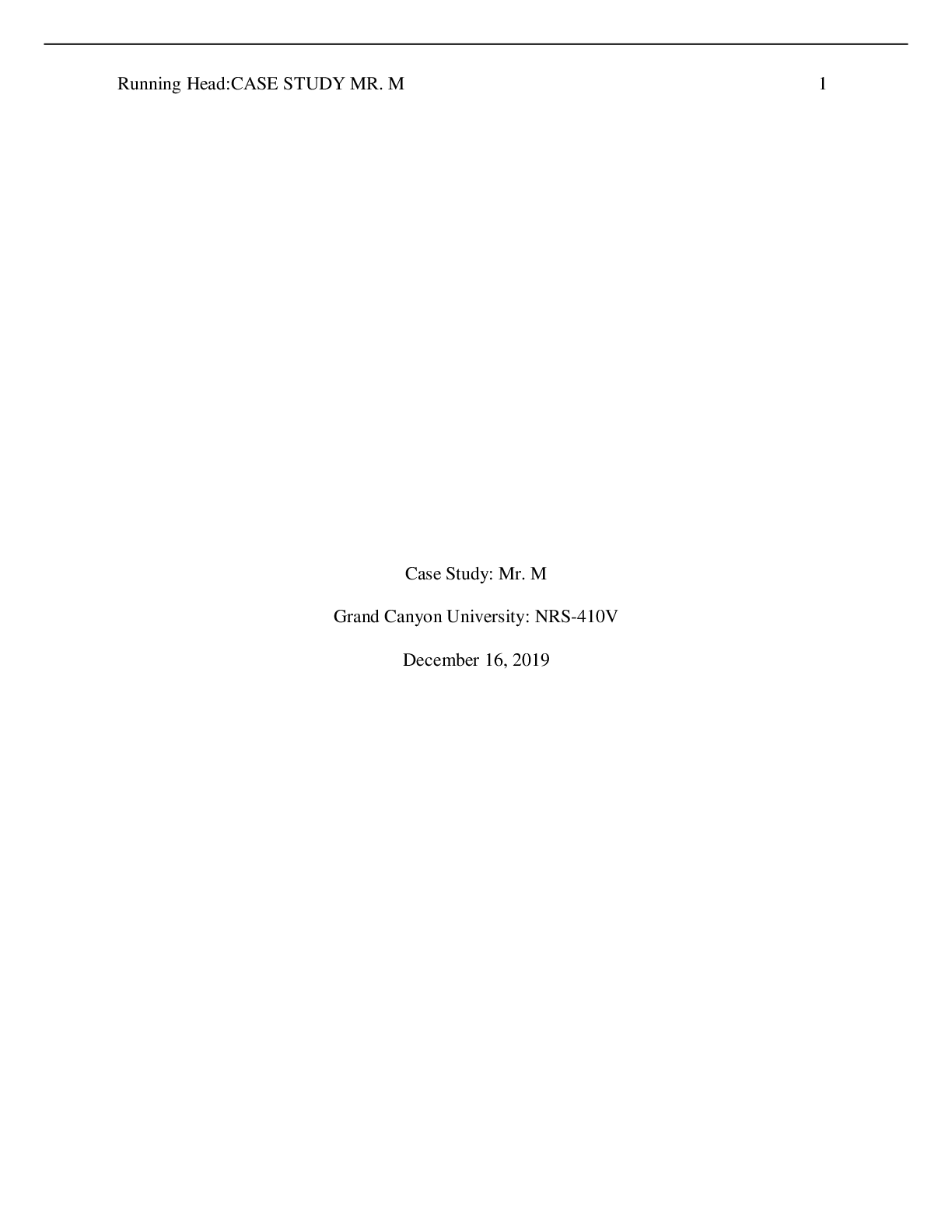



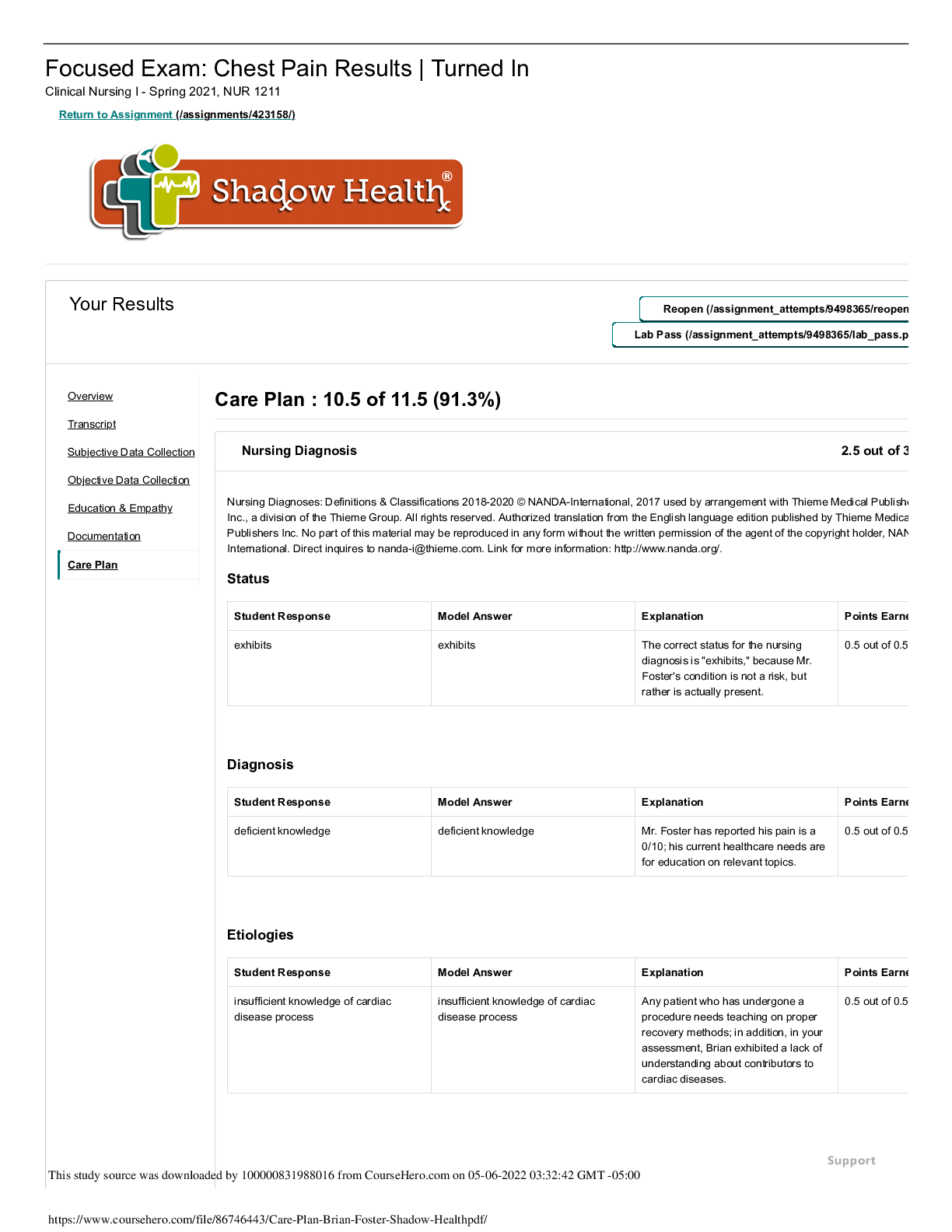
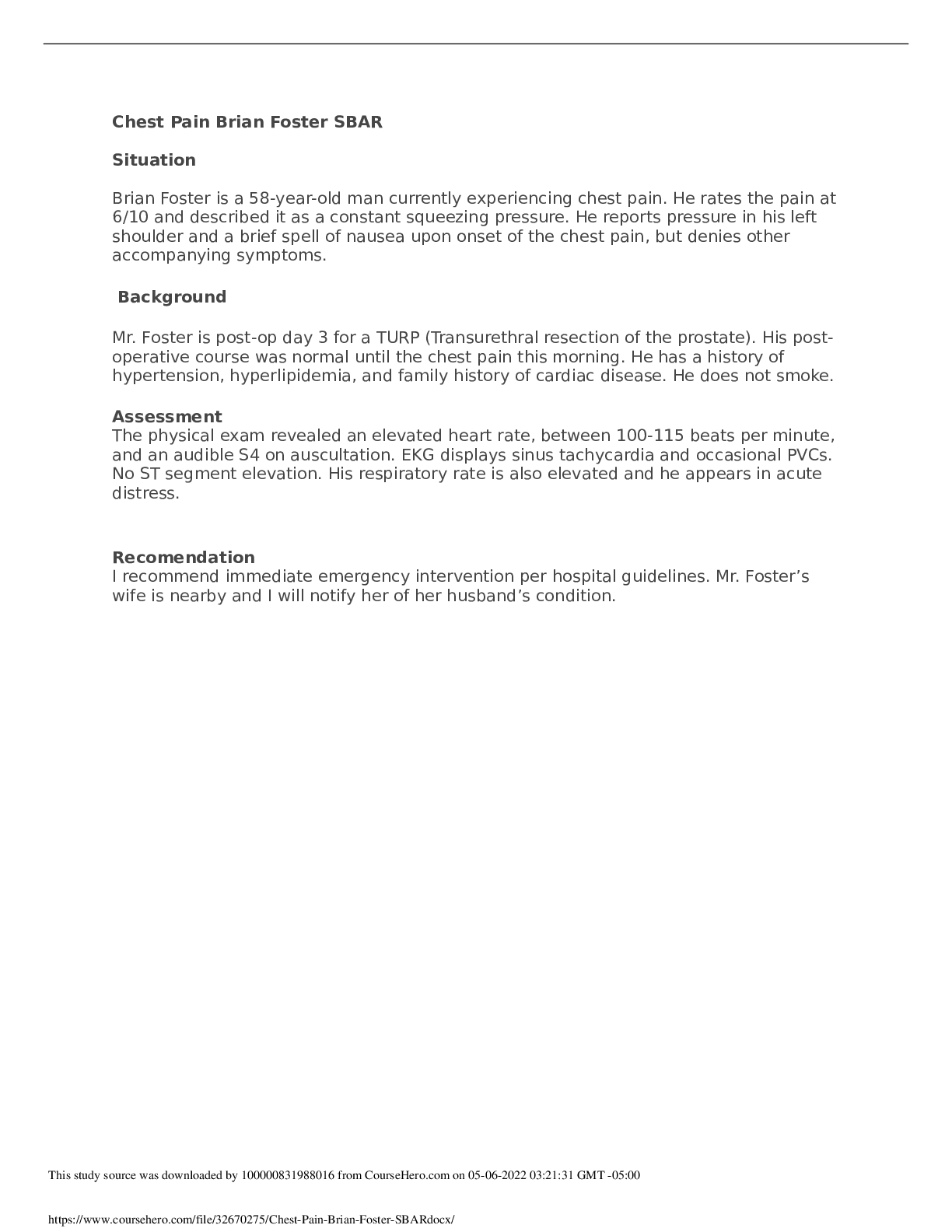
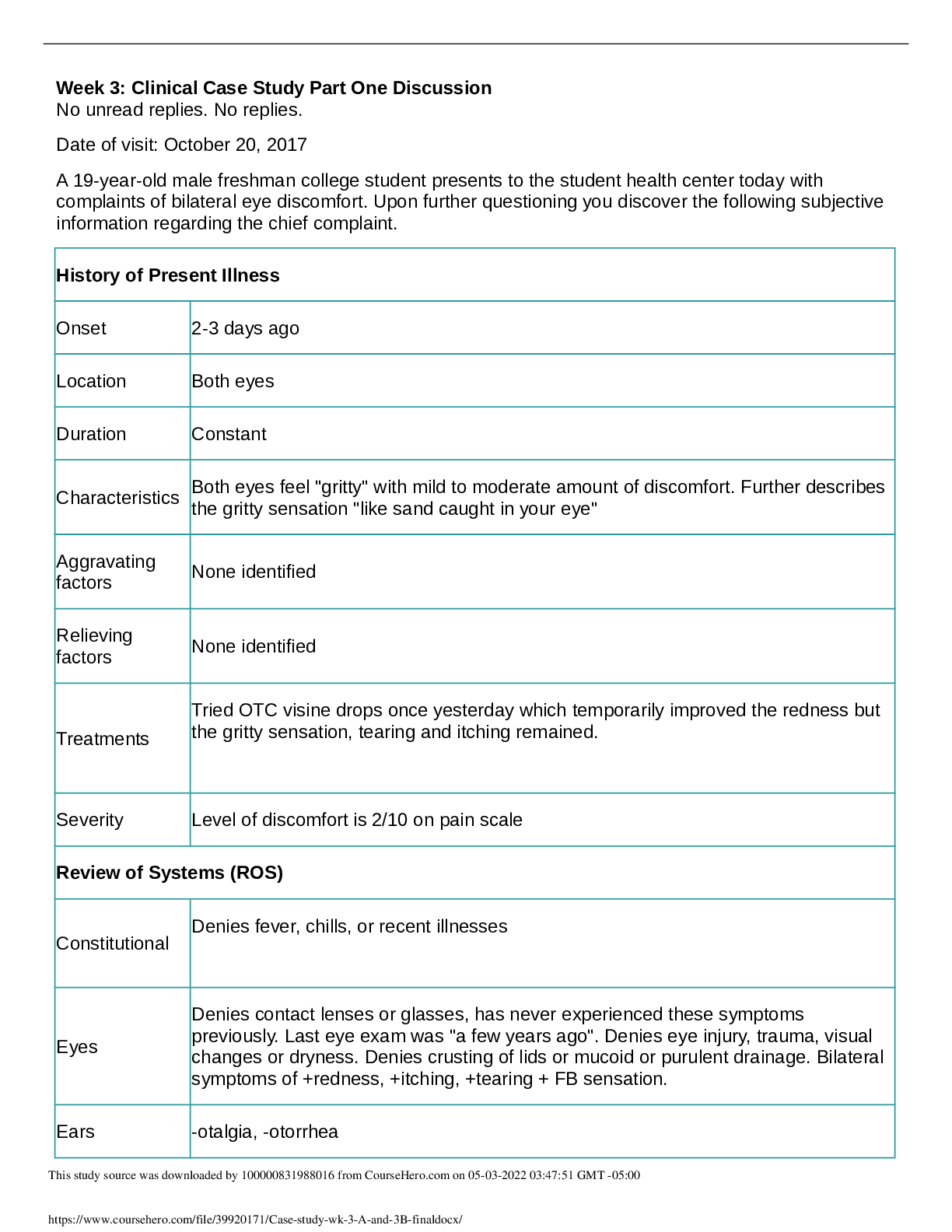

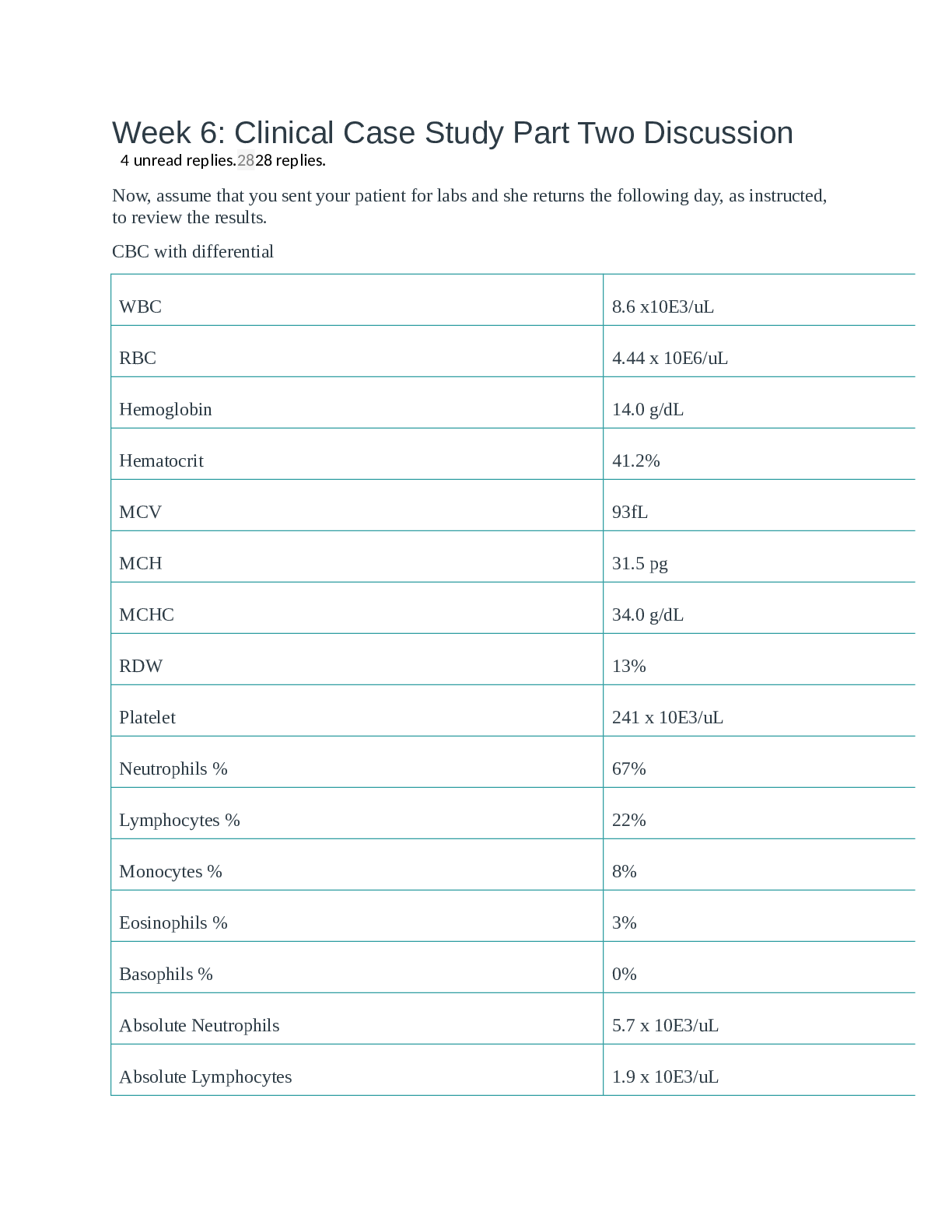

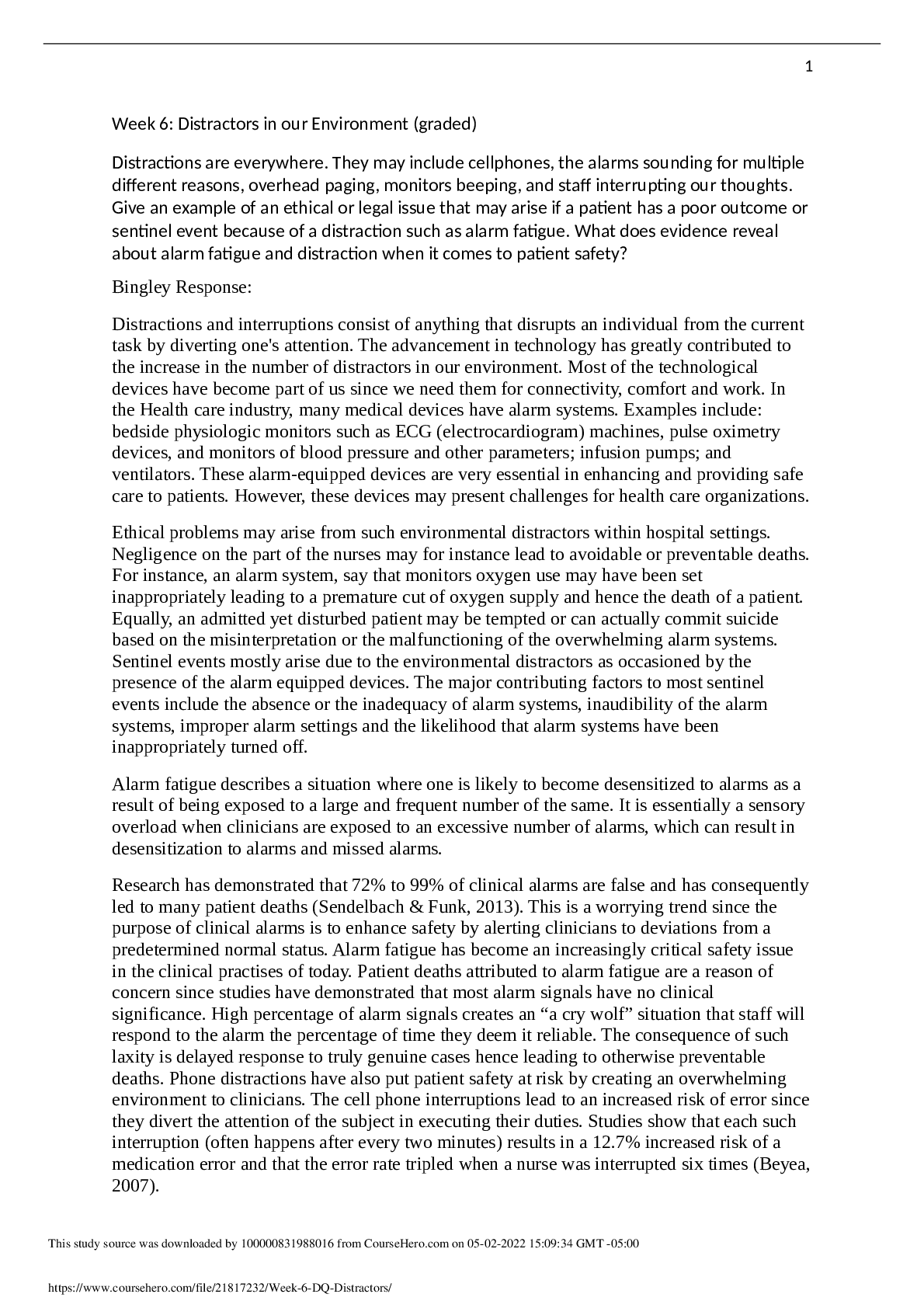



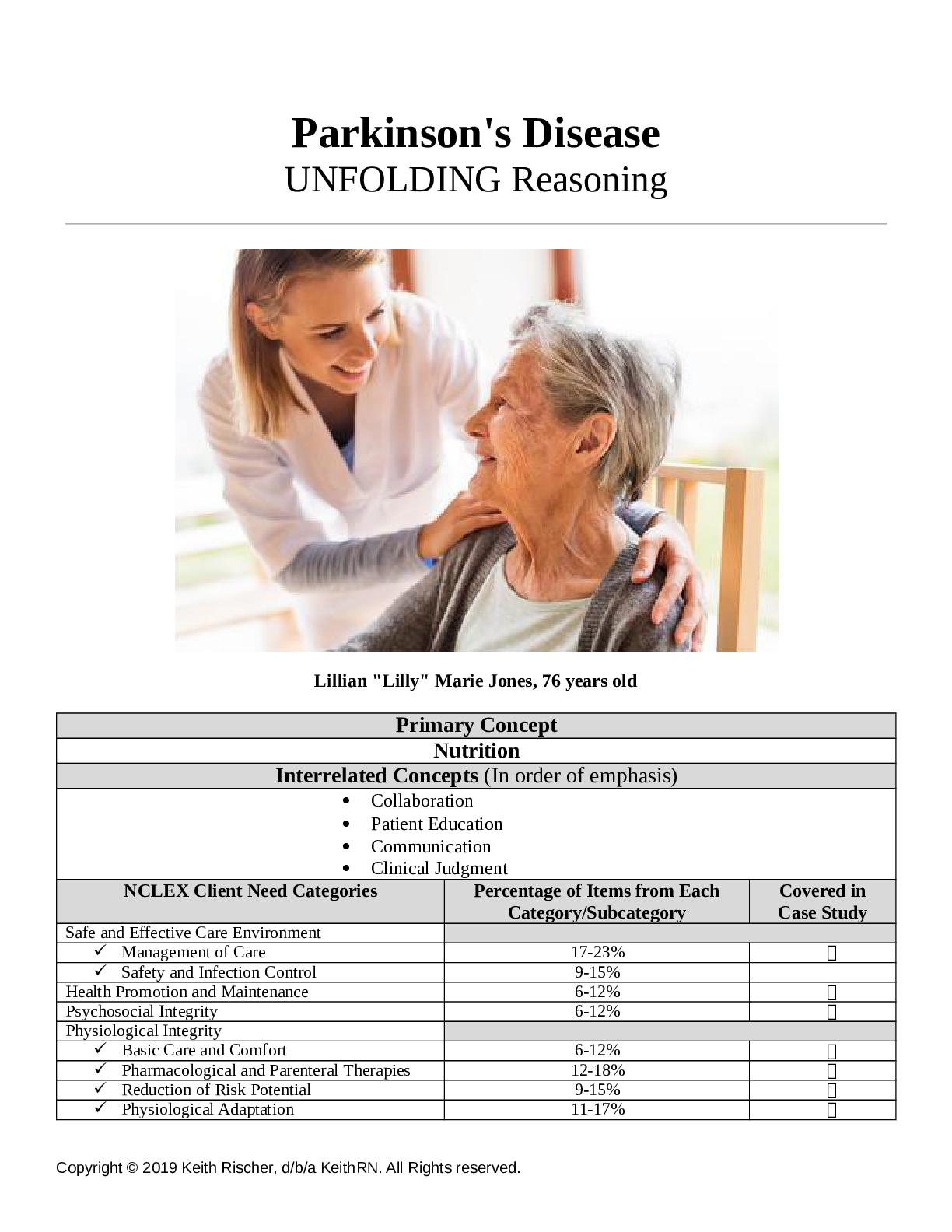
.png)
 PneumoniaChronic.png)
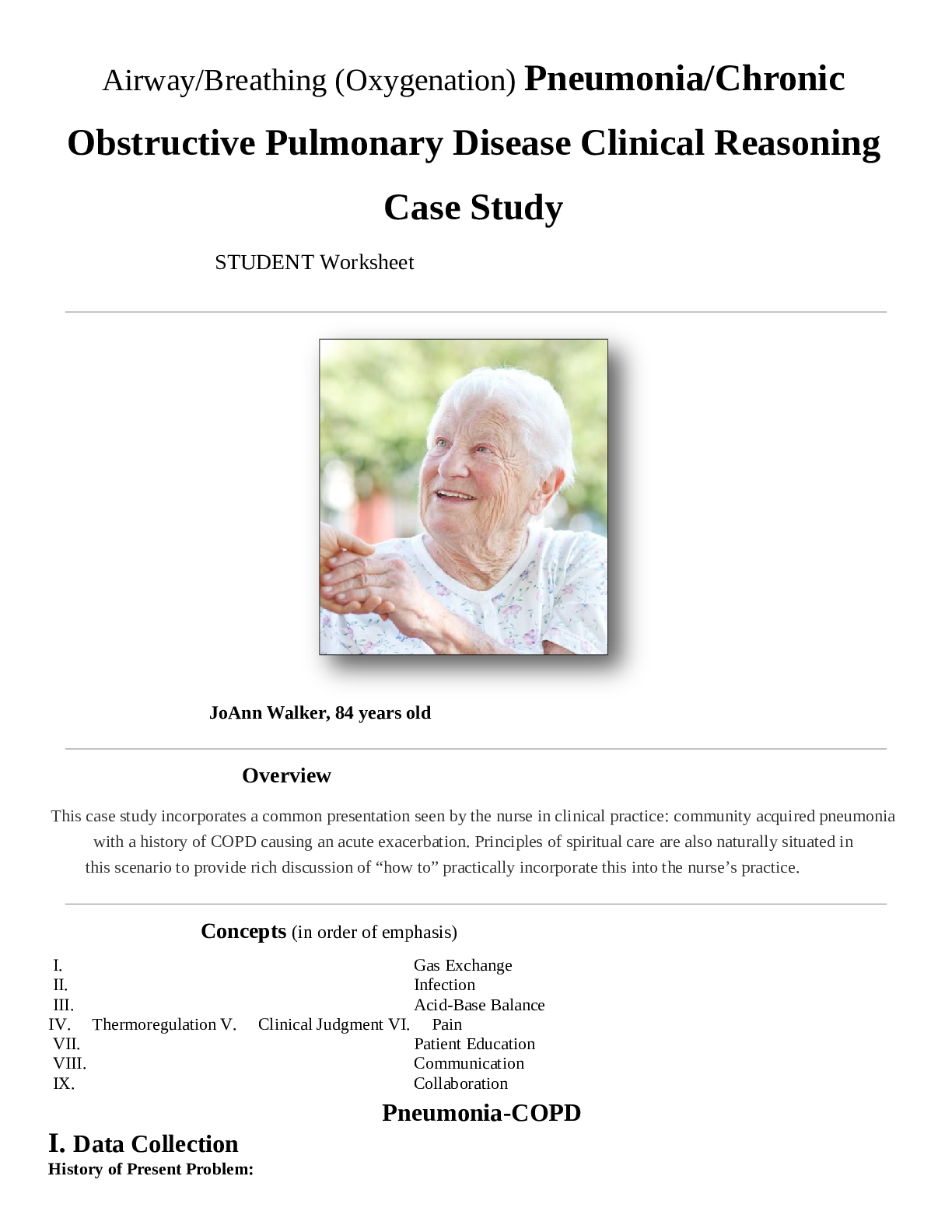
 Pneumonia Chronic Obstructive Pulmonary Disease Clinical Reasoning Case Study Medical surgical (NUR 201) Pneumonia-COPD case study solutions.png)
 Pneumonia Chronic Obstructive Pulmonary Disease Clinical Reasoning Case, Latest Grade A Correct Study Guide, Complete Solutions.png)
 Pneumonia Chronic Obstructive Pulmonary Disease Clinical Reasoning Case.png)


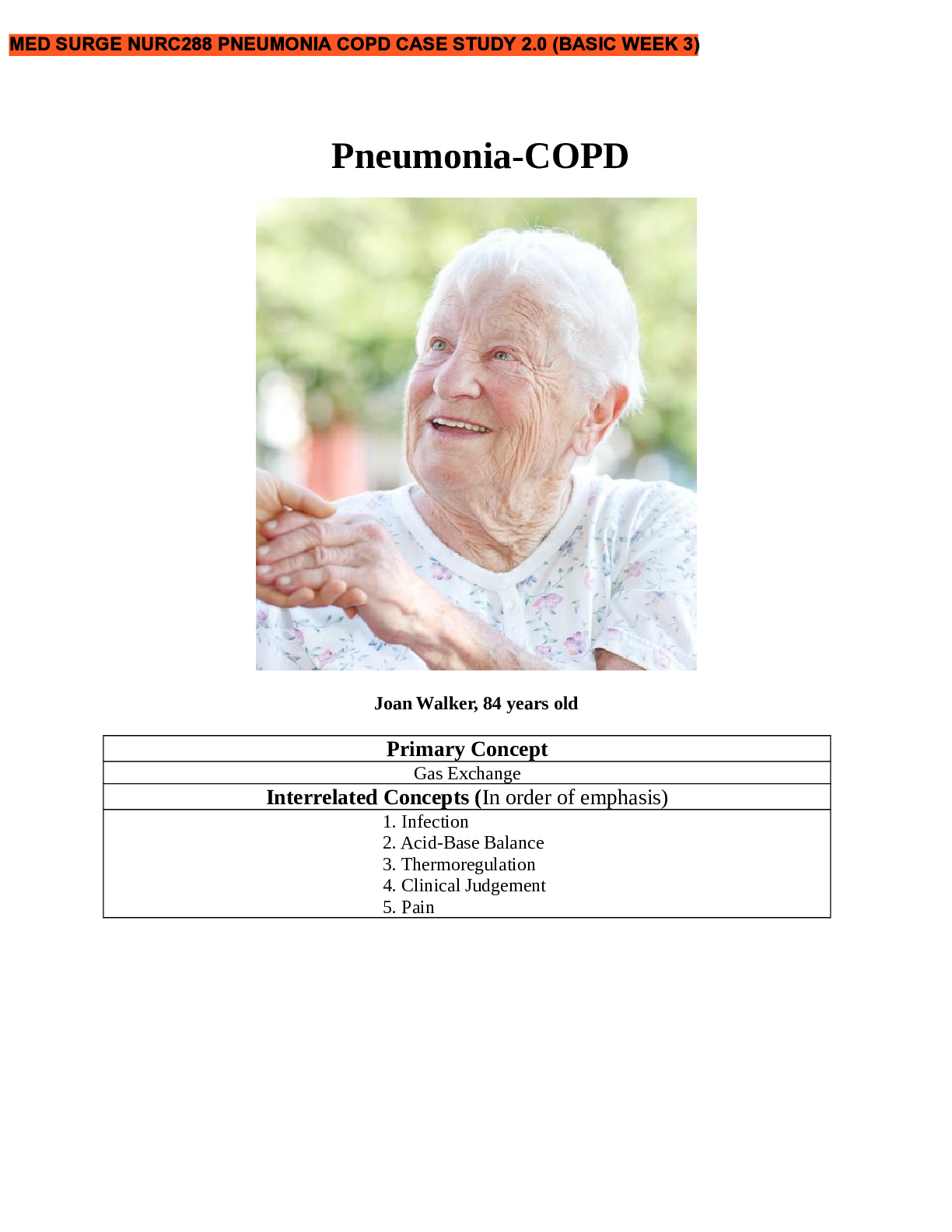

 Pneumonia Chronic Obstructive Pulmonary Disease Clinical Reasoning Case Study, STUDENT Worksheet, JoAnn Walker, 84 years old, (Latest 2021) Correct Study Guide,.png)

